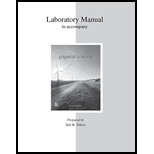
Concept explainers
If the insolation of the Sun shining on concrete is 7.3 102 W/m2, what is the change in temperature of a 1.5 m2 by 5.0 cm thick layer of concrete in 1 hr? (Assume the albedo of the concrete is 0.55, the specific heat of concrete is 0.16 cal/gC°, and the density of concrete is 2.4 g/cm3.)
The change in temperature of a
Answer to Problem 12PEB
Solution:
Explanation of Solution
Given data:
Insolation of the sun is
The albedo of the concrete is
The area of the layer
Time is 1 hr.
Density of concrete is
Thickness of the layer is
Specific heat of concrete is
Formula used:
Write the equation for the incoming solar radiation by the reflected solar radiation to determine the albedo.
Here,
Write the equation for energy from the absorbed solar radiation:
Here,
Write the formula for density.
Here,
Write the formula for volume.
Here,
Write the formula for heat.
Here,
Explanation:
Determine reflected radiation:
Recall the equation for the incoming solar radiation by the reflected solar radiation to determine the albedo, denoted by alpha.
Substitute
Convert hours to seconds:
Determine energy:
Recall the equation for energy from the absorbed solar radiation:
Substitute
Determine the mass of concrete:
Convert
Recall the formula for volume.
Recall the formula for density.
Substitute
Substitute
Convert energy to calorie heat:
Determine the temperature change of concrete.
Recall the formula for heat:
Substitute
Conclusion:
The change in temperature is
Want to see more full solutions like this?
Chapter 22 Solutions
Lab Manual for Physical Science
Additional Science Textbook Solutions
Integrated Science
Schaum's Outline of College Physics, Twelfth Edition (Schaum's Outlines)
Conceptual Physical Science Explorations
Fundamentals of Physics Extended
Glencoe Physical Science 2012 Student Edition (Glencoe Science) (McGraw-Hill Education)
University Physics Volume 2
- Chapter #8, Question #2: Use eqn. 8.4 (F = σT4) to show why the total flux of solar radiant energy is about 105 times greater than that from the Earth.arrow_forwardNortheastern Canada and much of Europe receive about the same amount of sunlight per unit area. Why, then, is Europe generally warmer in the winter?arrow_forwardIf the air temperature is 62°F at sea level, what is the temperature at the top of Pike's Peak (elevation 14,000 ft)?arrow_forward
- An incandescent light bulb with a surface area of 0.0136 m2 and an emissivity of 0.92 has a surface temperature of 187.6°C. If the temperature of the surroundings are 22.5°C, what is the net rate of radiation heat transfer between the bulb and the surroundings? [round your final answer to one decimal place]? {σ = 5.6704 x 10-8 W/(m2∙K4)}arrow_forwardWhy do clouds usually form high in the air instead of near Earth's surface?arrow_forwardCalculate the rate of heat conduction out of the human body assuming the following: A core internal temperature of 26 °C A skin temperature of 36.0 °C Fatty tissues between the core and the skin averaging 1.00 cm thick A surface area is 1.5 m2.arrow_forward
 An Introduction to Physical SciencePhysicsISBN:9781305079137Author:James Shipman, Jerry D. Wilson, Charles A. Higgins, Omar TorresPublisher:Cengage Learning
An Introduction to Physical SciencePhysicsISBN:9781305079137Author:James Shipman, Jerry D. Wilson, Charles A. Higgins, Omar TorresPublisher:Cengage Learning
